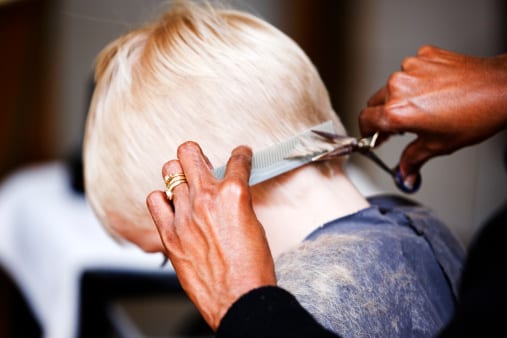 Here’s a common nightmare for parents – trying to get your autistic child’s hair cut or her nails trimmed. Have you had that experience? It’s not very fun for our kids.
Here’s a common nightmare for parents – trying to get your autistic child’s hair cut or her nails trimmed. Have you had that experience? It’s not very fun for our kids.
First, I’ll describe what I know about these two issues. My husband and I learned a long time ago that there was a possibility that our autistic child would have a negative reaction when it came to cutting his hair and clipping his nails.
Why?
We were told that people with autism often feel hair cutting and nail clipping much differently than typical people. They feel uncomfortable, they hear the “noise” of the clippers, and they can even experience pain.
Even though I cannot accurately know what my child went through while his hair was being cut or his nails were being clipped, but he was almost always uncomfortable in some way.
He is better with these two issues now that he’s older, yet neither of them are his favorite things to do. I have asked him a few times if he feels pain during those activities, but he’s never really answered my question.
What did we do?
Hair cutting: Our child was bald for the first year of his life. When his hair did finally start to grow, we didn’t cut it for a long time because we were so happy to see hair on his head. We really let it grow out and he had long, blonde locks.
Finally, I sucked it up and cut his hair but I did it myself at home. It was cheaper, I could do it in a familiar place, and I could do it quickly. The result was nowhere near a professional cut, but he was so cute that no one ever really noticed.
I cut his hair until he was around four. It was at this time that my poor cutting skills began to bother me. I knew it was time to try getting it cut at a salon.
By that time, we knew about our child’s autism and the problems associated with hair cutting. I probably cut his hair at home longer than I should have for fear of how he’d react in a hair salon.
I took him to a local salon and explained that this was my child’s first salon hair cut. Then, I told them that he has trouble getting his hair cut because it makes him feel uncomfortable.
This was not a salon that caters to special needs children (there are a few), and I don’t think they quite understood what I was saying. I didn’t mention autism because I didn’t want to spend the time explaining autism to them. I thought what I had said was sufficient.
The hairdresser and my child muddled through his first cut. Some hair got cut but she eventually had to stop. I paid and thanked her for her efforts and let her know I’d come back in a few weeks and try again. I told the hairdresser that I was committed to getting my child to be comfortable getting his hair cut.
It was helpful that his salon had a car hair cutting station for young children. It was a car and my child was into cars at that time. It did provide a bit of a distraction for a while anyway.
Then, the next hair cut went better, and then next and the next…so on.
Now that my son is older, I give him a heads up about hair cutting. I tell him a few days prior that he needs to get his hair cut soon. I tell him the day and approximate time I’m planning on taking him. I remind him that he has to tolerate the hair cutting, which for him means he has to keep his hands in his lap and his head still.
Also, he gets some kind of reward for a “job well done.” Typically it’s an extra ten minutes of computer time at night or a small bag of M n M’s.
Now, he gets through it. I still don’t think he’s all that comfortable, but he used to it.
Nail clipping: Nail clipping has been a harder road for our child. I remember a time when he was a toddler and we had to strap him into the stroller with my husband holding him down while I clipped.
My conclusion is that nail clipping has always bothered him more than hair cutting.
As he grew older, we eventually graduated from the stroller and I would cut his nails in a quiet place. Again, I always gave him advanced notice and promised some kind of small reward.
I would talk to him while clipping his nails to try to distract him. I would choose a preferred topic. Mostly, I did this to minimize the times he’d jerk his hand away and potentially cause a nail clipping miss.
How is nail clipping today?
Two cool things have happened recently regarding nail clipping.
First, my child and I had a great nail clipping conversation where he told me that he felt he was used to finger nail clipping but the toe nail clipping is the one that bothers him more. This was an awesome conversation and I thanked my child for sharing this information with me.
Second, my child volunteered one day to attempt cut his own nails. I had been driving in the car and my child was riding in the backseat. I had mentioned to him that I needed to cut his nails in the next day or so. Then, I said, “Do you want to try it yourself?”
I had asked him that question in the past and the response had always been, “I’d rather have you do it, mommy.” But, this time he had said, “Okay. Do you have the cutters?”
I had a pair of clippers in my car (or “cutters” as my child likes to call them). I quickly considered how I wasn’t all that crazy about nail clipping taking place inside my car, but then I decided to go with the moment. I could always get out the vacuum and clean it up.
I told my child that I had some “cutters” and I asked him if he was ready to try it right now. He said, “Yes.” I handed him the clippers and he tried it.
I kept my concentration on my driving but I knew I couldn’t wait to find out how he had done.
Finally, he said he was finished. I congratulated him on his accomplishment and I told him that he had taken a big step. I said, “Nail clipping had always been hard for you and you should be proud of yourself for overcoming your fear.”
When I finally inspected his hands, the nail clipping job he had done wasn’t all that great but I didn’t care. He had done it by himself! We told Daddy and Daddy also congratulated him.
Children with autism do have legitimate issues with hair cutting and nail clipping. Please don’t ignore these issues. They are causes for anxiety in our kids and need to be handled with care and sensitivity. There are ways to overcome these issues. Just give it time and talk with your child.
To Find Kimberly Kaplan:
www.kimberlykaplan.com
www.smashwords.com or Amazon Kindle ebook “A Parents’ Guide to Early Autism Intervention”
Twitter: @tipsautismmom





